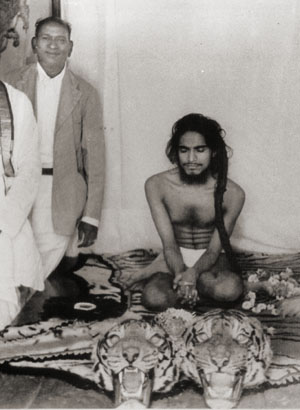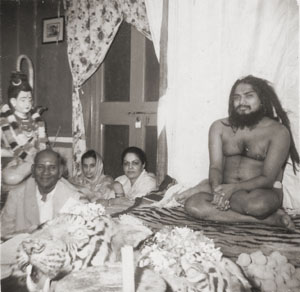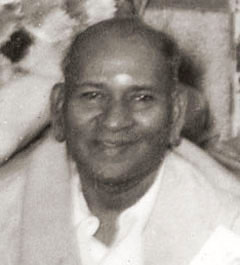SOUL CONNECTIONS HOME | PREVIOUS PAGE | NEXT PAGE

Garaga Narasimha Murthy standing next to Swamiji's asana, Adivarapupeta, probably in March of 1963.
Garaga Narasimha Murthy
The side walls of the meditation hall of Shri Swamiji’s Bangalore ashram are lined with framed photographs of Shivabalayogi, including those taken during his twelve-year tapas. Towards the hall entrance there are photos of several devotees who served and protected Swamiji during his early years in Bangalore and traveling around India. These were bold personalities, the kind of devotee Swamiji admonishes everyone to be: have courage and be fearless, even as he was as a boy.
One photo identifies Garaga Narasimha Murthy with the words “Swamiji’s first devotee.” He was the tehsildar who came to Shivabalayogi in late 1949 or early 1950. A tehsildar (the Arabic-Persian word goes back to Moslem rule) is a local tax collector official. Garaga Narasimha Murthy was the tehsildar of Ramachandrapuram, a small town about two or three miles from Adivarapupeta.
A few months after fourteen-year-old Sathyaraju was made to sit in tapas, Murthy had a dream of a young boy-yogi. The boy asked for his help. Murthy did not think much about the dream, but the next night he had the same dream. The third night he again dreamed of a boy yogi asking for his help.
The following day he decided to ask around to find out whether there was any boy like he had seen in his dreams. Adivarapupeta was within Murthy’s jurisdiction and it was the tehsildar’s job to know what was going on in his district. After making a few inquiries, Murthy learned about a young boy sitting in tapas in Adivarapupeta. He made arrangements to visit the boy yogi.
Murthy went to the field where the young yogi was sitting inside a hut made of palmyra and coconut tree branches, gunnysack, and whatever else was available. This was in the field outside Adivarapupeta used by the villagers as a cemetery for children. A cobra had taken up residence inside that hut. The snake served to protect the young yogi. The uninvited curious who peeked inside would be greeted by the cobra, its head reared, hood flared out, and hissing loudly. Murthy reverently entered the hut without making any noise or saying anything.
Swamiji came out of samadhi, opened his eyes and told the tehsildar, “I am waiting for you.”
![]()
Murthy served and protected the Adivarapupeta Balayogi beginning with that first darshan. During Shivabalayogi’s tapas, it was Murthy, the zamindar Vattakoota Pattabhiramanna who owned the field, Ravula Sathyam, T. V. Sathyanarayan Rao, Dr. Appalaswamy, and a handful of others who protected the yogi.
During his visits to Adivarapupeta, Murthy would inquire and make sure that no one was troubling the yogi. The tehsildar was a strong man and being a government official, no one dared question if he were to punish a wrongdoer. If he heard that some villager had caused Swamiji some trouble, he would personally administer a sound beating. In this way, troublemakers were prevented from making even more mischief.
Murthy generally would visit about once a week, and during the last four years of tapas he and Sathyanarayan Rao would often stay at the ashram all night. During these visits, Swamiji would tell them everything his guru, Lord Shiva, had told him since the last visit. When Swamiji was in mouna (silence, i.e., a vow of not talking), which sometimes lasted a year or more, Murthy and Sathyanarayan Rao used to bring a slate and some chalk so Swamiji would write what Shiva had told him. In the morning, Swamiji put vibhuti on their foreheads and asked them to go back to work. When they got home they would relate everything to their families.
![]()
Murthy’s superior, Bala Sundaram Pillai was the tax collector of the East Godavari District. Pillai donated a tiger skin for Swamiji’s meditation seat. When Murthy delivered the skin, he noticed that the ground on which Swamiji was sitting was damp. It was obvious that if the tiger skin were spread on the ground it would soon rot. To prevent this, he had a wooden platform erected on which he spread the tiger skin. He also added to the canopy of palmyra leaves built over the platform. Additional gunny sacks were hung around the sides to afford some protection from the elements and onlookers. The hut greatly relieved Swamiji’s torment from the animals and insects that plagued him and he was able to continue his tapas in relatively greater comfort.

Garaga Narasimha Murthy sitting on the left.
Photo, probably from the early 1970's, taken inside the darshan room of the
Adivarapupeta ashram building, In the picture,
Mataji, Swamiji's second mother, is sitting closest to Swamiji.
Murthy and Sathyanarayan discussed the idea of a permanent building, a sort of meditation temple (dhyana mandir) in which the yogi would be more comfortable. They approached the owner of the field in which Swamiji was sitting, the zamindar (landowner) from Vella named Vattakoota Pattabhiramanna. The zamindar readily agreed to provide the land. With the blessings of Swamiji, Murthy took up the job of collecting donations to build what became the Dhyana Mandir where Shivabalayogi meditated for almost ten of his twelve-year tapas.
![]()
If Murthy wanted to see Swamiji, he could immediately see the yogi on the palm of his hand. On other occasions, vibhuti manifested and he could see Swamiji in the vibhuti. He would call children and say, “Come on. See? He is there.” Sometimes the tehsildar would apply blessed vibhuti on his forehead and play with the children and show the vibhuti. “Look! What do you see here in my vibhuti?” They could see Swamiji on his hand, or on his forehead, or in the vibhuti. They would see Swamiji seated in meditation.
There were times when Murthy was working in his office and Swamiji manifested on his desk to give him instructions, perhaps to call him to the ashram for some specific purpose. At other times, Swamiji would appear to tell Murthy about some function his family had planned at the house, or to give instructions on some other matter.
![]()
 About a year before Swamiji completed tapas, he asked Murthy to sit on the dais,
the same platform on which Swamiji was sitting. Swamiji instructed him to close
his eyes and just watch. Whatever happened, Swamiji warned, Murthy was not to
open his eyes. After a little while, Murthy saw Lord Shankara with his neck
garlanded by a cobra, matted hair jatas piled on his head and flowing over his
shoulders. Shiva was wearing animal skins and his body was covered with white
ash.
About a year before Swamiji completed tapas, he asked Murthy to sit on the dais,
the same platform on which Swamiji was sitting. Swamiji instructed him to close
his eyes and just watch. Whatever happened, Swamiji warned, Murthy was not to
open his eyes. After a little while, Murthy saw Lord Shankara with his neck
garlanded by a cobra, matted hair jatas piled on his head and flowing over his
shoulders. Shiva was wearing animal skins and his body was covered with white
ash.
The vision was so powerful that Murthy was frightened and unable to bear it. He could not help but open his eyes. Swamiji was disappointed and asked, “Why did you open your eyes? Parvati was also following.” Although Murthy could not yet see Parvati, during the vision he could hear the tinkling sound of her ankle jewelry.
![]()
Murthy used to send regular donations of money to Swamiji’s mother to meet the cost of buying fruit and milk for Swamiji. He continued this service for the entire period of tapas and afterwards. He was a custodian of the key to the meditation room and the only devotee who could arouse Swamiji from samadhi. All he had to do was gently tap Swamiji and this was enough to bring the yogi back to normal consciousness.
Murthy made it a daily practice to take some flowers from his garden and offer them to Swamiji. Swamiji once said that in one of Murthy’s past lives, he was a gardener for Swamiji. It was as if he had to continue the service in this life.


